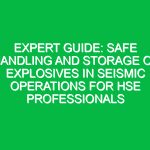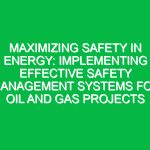In the dynamic and often hazardous world of oil and gas exploration, ensuring the safety of personnel and equipment is paramount. Among the myriad of safety concerns, vehicle safety stands out due to the critical role transportation plays in these operations. This article delves into the essential vehicle safety practices necessary for minimizing risks and safeguarding lives in oil and gas exploration sites. By adhering to these practices, companies can foster a culture of safety that not only protects their employees but also enhances operational efficiency.
Understanding the Risks
Before diving into the safety practices, it’s crucial to understand the risks associated with vehicle operations in oil and gas exploration sites. These environments are fraught with potential hazards, including rough terrain, extreme weather conditions, and the presence of flammable materials. Accidents can range from minor vehicle collisions to catastrophic events with far-reaching consequences. Recognizing these risks is the first step toward mitigating them.
Key Vehicle Safety Practices
To maximize protection on oil and gas exploration sites, several vehicle safety practices must be implemented and adhered to rigorously. These practices encompass a broad spectrum of measures, from vehicle maintenance to driver training and emergency preparedness.
Regular Vehicle Maintenance and Inspections
Ensuring that all vehicles are in top working condition is foundational to safety. Regular maintenance checks and inspections can identify and rectify potential issues before they lead to accidents. This includes checking brakes, tires, lights, and other critical systems. A well-maintained vehicle is less likely to malfunction, reducing the risk of accidents.
Driver Training and Certification
Equally important is ensuring that all drivers are properly trained and certified. This training should cover not only basic driving skills but also defensive driving techniques and specific challenges related to driving in oil and gas exploration sites. Drivers should be familiar with the terrain, weather conditions, and any site-specific hazards.
Use of Safety Equipment
Vehicles should be equipped with essential safety equipment, including seat belts, airbags, and fire extinguishers. Additionally, depending on the specific risks associated with a site, vehicles may need to be outfitted with specialized equipment such as rollover protection structures (ROPS) and explosion-proof components.
Implementing Strict Safety Protocols
Developing and enforcing strict safety protocols is critical. These protocols should cover all aspects of vehicle operation, from speed limits and right-of-way rules to procedures for reporting accidents and near-misses. Clear, comprehensive protocols help ensure that all personnel understand their responsibilities and the actions they need to take to maintain safety.
Emergency Preparedness
Despite the best preventive measures, accidents can still occur. Therefore, it’s essential to have a well-defined emergency response plan in place. This plan should include procedures for dealing with vehicle accidents, including rescue operations, medical treatment, and incident investigation. Regular drills and training can help ensure that everyone knows how to respond in an emergency.
Technological Advancements Enhancing Vehicle Safety
Technology plays a pivotal role in enhancing vehicle safety in oil and gas exploration sites. Innovations such as GPS tracking, collision avoidance systems, and vehicle stability control can significantly reduce the risk of accidents. These technologies provide drivers with real-time information and automated assistance to help them navigate safely, even in challenging conditions.
Creating a Culture of Safety
Ultimately, the effectiveness of vehicle safety practices depends on the culture of safety within an organization. This culture is built on a foundation of commitment from top management, continuous training, and open communication. Encouraging a proactive approach to safety, where all personnel feel responsible for not only their safety but also that of their colleagues, can lead to significant improvements in overall safety performance.
Conclusion
Maximizing protection on oil and gas exploration sites requires a comprehensive approach to vehicle safety. By understanding the risks, implementing essential safety practices, leveraging technology, and fostering a culture of safety, companies can significantly reduce the likelihood of vehicle-related accidents. Regular vehicle maintenance and inspections, driver training and certification, the use of safety equipment, strict safety protocols, and emergency preparedness are all critical components of a robust vehicle safety program. As the industry continues to evolve, staying abreast of technological advancements and best practices in vehicle safety will be crucial for maintaining and enhancing safety standards. Remember, safety is not just a regulation; it’s a commitment to protecting lives and ensuring the well-being of all personnel on site.
In summary, the key points to remember for maximizing vehicle safety in oil and gas exploration sites include:
- Understanding the inherent risks associated with vehicle operations in these environments.
- Implementing regular vehicle maintenance and inspections to prevent malfunctions.
- Ensuring drivers are properly trained and certified to handle site-specific challenges.
- Equipping vehicles with necessary safety equipment and adhering to strict safety protocols.
- Leveraging technology to enhance vehicle safety and preparedness for emergencies.
- Building and maintaining a culture of safety that prioritizes the well-being of all personnel.
By embracing these practices, oil and gas exploration companies can safeguard their most valuable asset— their people—while maintaining operational efficiency and compliance with industry standards.


